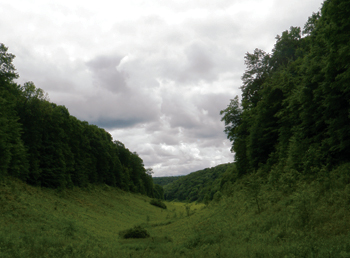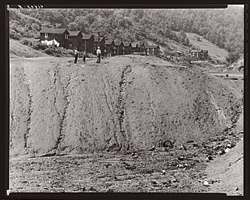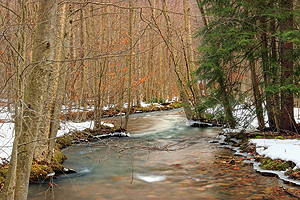Bennett Branch Forest
WPC Explores Ways to Improve Stream’s Tributary

The section of the Allegheny Plateau that runs through Pennsylvania’s Elk and Clearfield counties is characterized by its rough, hilly land and its narrow valleys flanked by steep slopes. The area’s many creeks and streams cut through shale and sandstone formations, while its hardwood forests create great habitat for white-tailed deer, black bears and turkey.
The 1,500-acre Bennett Branch Forest is tucked within this terrain, sharing a border with Moshannon State Forest. A network of streams traverses this corridor, feeding the Bennett Branch of Sinnemahoning Creek. This is an important watershed because the Sinnemahoning eventually meets the West Branch of the Susquehanna River, which flows to the Chesapeake Bay.
Since the Western Pennsylvania Conservancy acquired Bennett Branch Forest more than six years ago, it has worked to restore and sustainably manage this property. The Conservancy’s efforts continue as it begins to focus on Cherry Run, a tributary of the Bennett Branch stream.
The Bennett Branch’s headwaters are in northern Clearfield County and its watershed stretches into Elk County. The stream flows northeast into Cameron County until it meets the Driftwood Branch to form Sinnemahoning Creek.
It was once a nationally noted fishing stream – in fact, it was a favorite destination for U.S. President Ulysses Grant. Around the time of Grant’s last trip to the area, however, loggers began to cut down the forests’ timber and companies began mining coal in the region. By the early 1900s, underground mining began; surface mining in the Bennett Branch watershed began about 40 years later, according to the Pennsylvania Department of Environmental Protection’s Bureau of Abandoned Mine Reclamation. Although many of the area’s mine operations have closed down, abandoned surface and deep mines remain, polluting 33 miles of Bennett Branch with mine drainage.

This 1920 photo shows the town of Cardiff, Pa., along Cherry Run.
For more than 30 years, a host of other nonprofits and government agencies have committed to projects to restore the Bennett Branch. The Bennett Branch Watershed Association has worked to remediate the stream and other entities, such as the state Department of Environmental Protection and the P&N Coal Company, among others, have worked on stream restoration projects.
The late Dr. Colson “Doc” E. Blakeslee, a WPC board member, was a longtime advocate of the remediation of Bennett Branch. Blakeslee supported the acquisition of land by DEP along the stream itself, the construction on that property of a $14 million abandoned mine drainage treatment facility and the subsequent remediation of Bennett Branch (see related article, page 9).
This area is now in the midst of a recovery, being stocked with trout for the first time in years.
About six miles away from that plant, near the town of Force, Pa., efforts are in the planning stages for reducing mining impact to Cherry Run.
WPC’s Watershed Conservation program has undertaken a project, funded through the Headwaters RC&D Council Sinnemahoning Grant Program, to visually assess the stream and identify pollution sources. The staff, in cooperation with DEP’s Bureau of Conservation and Restoration, also took a year’s worth of water samples from Cherry Run.
WPC staff found it to be a good physical habitat, with riffles and pools to attract fish, bugs and other aquatic species. However, abandoned mine drainage has impaired Cherry Run’s water quality, said Mark Killar, a watershed manager at the Conservancy.
AMD is toxic water – usually polluted with iron, aluminum, manganese or other metals – that can result from mining activity. Red, orange or yellow streams are often signs of AMD runoff, which can contaminate drinking water and harm aquatic plants and animals. While many think of “acid mine drainage” when they hear AMD, the acronym actually refers to abandoned mine drainage, alkaline mine drainage and metal mine drainage, according to the U.S. Environmental Protection Agency.

The waters of Cherry Run now rush past its banks in this photo taken in March.
Photo courtesy of Nicholas Tonelli
Acid mine drainage often refers to water with high concentrations of sulfuric acid that is draining from mines. The acidic water is often caused by rainwater percolating through layers of exposed sulfur-rich coal.
“We have taken water samples and flow measurements from the major AMD discharges. Based on chemistry and flow, you can develop a conceptual design for a treatment system,” Killar said.
Active AMD treatment involves adding a neutralizing agent or chemical to the water that has been impacted, while passive treatment involves the use of naturally occurring biological and chemical processes to clean contaminated water. For example, watershed managers may decide to use a limestone pond that would neutralize the runoff as it flows away from the discharge site.
WPC’s watershed conservation program will explore next steps once it secures funding, Killar said.
Get Involved
You can help WPC by volunteering your time! Click here to learn more.
